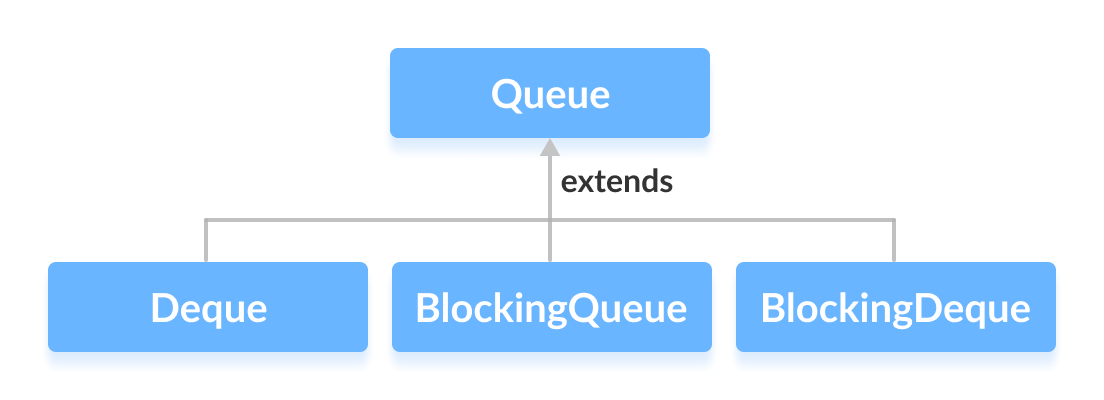在Java中,Queue(队列)是一种基本的数据结构,用于按照先进先出(FIFO)的顺序存储元素。Java提供了多种实现Queue接口的类,以下是几种常见的实现方式:

- LinkedList:LinkedList实现了Queue接口,并且支持队列的所有操作,包括添加元素到队尾、获取队头元素、删除队头元素等。
Queue<String> queue = new LinkedList<>();
queue.add("element1"); // 添加元素到队尾
String element = queue.peek(); // 获取队头元素
String removedElement = queue.remove(); // 删除队头元素 2. ArrayDeque:ArrayDeque也实现了Queue接口,并且支持队列的操作。它使用可调整大小的数组来存储元素,可以在队列的两端进行高效地插入和删除操作。
Queue<String> queue = new ArrayDeque<>();
queue.offer("element1"); // 添加元素到队尾
String element = queue.peek(); // 获取队头元素
String removedElement = queue.poll(); // 删除队头元素 3. PriorityQueue:PriorityQueue是一种基于优先级的队列,它允许你根据元素的自然顺序或自定义的Comparator来确定元素的优先级。
Queue<Integer> queue = new PriorityQueue<>();
queue.offer(3); // 添加元素到队列并根据优先级排序
queue.offer(1);
queue.offer(2);
int element = queue.peek(); // 获取优先级最高的元素
int removedElement = queue.poll(); // 删除并返回优先级最高的元素 通过使用上述的Queue实现类,你可以根据具体的需求选择适合的队列实现,并进行相应的操作。
继承Queue的接口
Queue接口还可以被各种子接口继承:
Deque
BlockingQueue
BlockingDeque


队列数据结构的工作流程
在队列中,以先进先出的方式存储和访问元素。也就是说,从后面添加元素,从前面删除元素。


如何使用队列(Queue)?
在Java中,必须导入java.util.Queue包才能使用Queue。
// 使用 LinkedList 创建
Queue<String> animal1 = new LinkedList<>();
// 使用 ArrayDeque 创建
Queue<String> animal2 = new ArrayDeque<>();
// 使用 PriorityQueue创建
Queue<String> animal 3 = new PriorityQueue<>();在这里,我们分别创建了类LinkedList,ArrayDeque和PriorityQueue的对象Animal1,Animal2和Animal3。 这些对象可以使用Queue接口的功能。
Queue的方法
Queue接口包括Collection接口的所有方法。 这是因为Collection是Queue的超级接口。
Queue接口的一些常用方法是:
add() - 将指定的元素插入队列。如果任务成功,则add()返回true,否则将引发异常。
offer() - 将指定的元素插入队列。如果任务成功,则offer()返回true,否则返回false。
element() - 返回队列的开头。如果队列为空,则引发异常。
peek() - 返回队列的开头。 如果队列为空,则返回null。
remove() - 返回并删除队列的头部。如果队列为空,则引发异常。
poll() - 返回并删除队列的开头。 如果队列为空,则返回null。
队列接口的实现
1.添加元素: 为了在队列中添加一个元素,我们可以使用add()方法。在PriorityQueue中不保留插入顺序。元素是根据优先级顺序存储的,默认是升序的。
例子
// Java program to add elements
// to a Queue
import java.util.*;
public class GFG {
public static void main(String args[])
{
Queue<String> pq = new PriorityQueue<>();
pq.add("Geeks");
pq.add("For");
pq.add("Geeks");
System.out.println(pq);
}
}输出
[For, Geeks, Geeks]2.删除元素: 为了从队列中删除一个元素,我们可以使用remove()方法。如果有多个这样的对象,那么第一个出现的对象将被删除。除此之外,poll()方法也被用来删除头部并返回。
例子
// Java program to remove elements
// from a Queue
import java.util.*;
public class GFG {
public static void main(String args[])
{
Queue<String> pq = new PriorityQueue<>();
pq.add("Geeks");
pq.add("For");
pq.add("Geeks");
System.out.println("Initial Queue " + pq);
pq.remove("Geeks");
System.out.println("After Remove " + pq);
System.out.println("Poll Method " + pq.poll());
System.out.println("Final Queue " + pq);
}
}输出
Initial Queue [For, Geeks, Geeks]
After Remove [For, Geeks]
Poll Method For
Final Queue [Geeks]3.遍历队列: 有多种方法来遍历队列。最著名的方法是将队列转换为数组并使用for循环进行遍历。然而,队列也有一个内置的迭代器,可以用来遍历队列。
例子
// Java program to iterate elements
// to a Queue
import java.util.*;
public class GFG {
public static void main(String args[])
{
Queue<String> pq = new PriorityQueue<>();
pq.add("Geeks");
pq.add("For");
pq.add("Geeks");
Iterator iterator = pq.iterator();
while (iterator.hasNext()) {
System.out.print(iterator.next() + " ");
}
}
}输出
For Geeks Geeks队列的特点: 以下是队列的特点。
- 队列用于在队列的末端插入元素,并从队列的开头删除。它遵循FIFO概念。
- Java队列支持集合接口的所有方法,包括插入、删除等。
- LinkedList、ArrayBlockingQueue和PriorityQueue是最常使用的实现方式。
- 如果对阻塞队列进行任何空操作,就会抛出NullPointerException。
- java.util包中的队列是无界队列。
- java.util.concurrent包中的队列是有界队列。
- 除了Deques之外,所有的队列都分别支持在队列的尾部和头部进行插入和删除。Deques支持两端的元素插入和删除。
实现队列接口的类
1.PriorityQueue: 在集合框架中实现的PriorityQueue类为我们提供了一种根据优先级来处理对象的方法。众所周知,队列遵循先入先出的算法,但有时需要根据优先级来处理队列中的元素,这时PriorityQueue就发挥作用了。让我们看看如何使用这个类来创建一个队列对象。
例子
import java.util.*;
class Zeus {
public static void main(String args[])
{
// Creating empty priority queue
Queue<Integer> pQueue
= new PriorityQueue<Integer>();
// Adding items to the pQueue
// using add()
pQueue.add(10);
pQueue.add(20);
pQueue.add(15);
// Printing the top element of
// the PriorityQueue
System.out.println(pQueue.peek());
// Printing the top element and removing it
// from the PriorityQueue container
System.out.println(pQueue.poll());
// Printing the top element again
System.out.println(pQueue.peek());
}
}输出
10
10
152. LinkedList: LinkedList是一个在集合框架中实现的类,它内在地实现了链接列表数据结构。它是一个线性数据结构,其中的元素不存储在连续的位置,每个元素都是一个独立的对象,有数据部分和地址部分。这些元素使用指针和地址进行链接。每个元素被称为一个节点。由于其动态性和易于插入和删除的特点,它们比数组或队列更受欢迎。让我们看看如何使用这个类来创建一个队列对象。
例子
import java.util.*;
class Zeus {
public static void main(String args[])
{
// Creating empty LinkedList
Queue<Integer> ll
= new LinkedList<Integer>();
// Adding items to the ll
// using add()
ll.add(10);
ll.add(20);
ll.add(15);
// Printing the top element of
// the LinkedList
System.out.println(ll.peek());
// Printing the top element and removing it
// from the LinkedList container
System.out.println(ll.poll());
// Printing the top element again
System.out.println(ll.peek());
}
}输出
10
10
203. PriorityBlockingQueue: 需要注意的是,PriorityQueue和LinkedList的实现都不是线程安全的。如果需要线程安全的实现,PriorityBlockingQueue是一个替代性的实现。PriorityBlockingQueue是一个无界的阻塞队列,它使用与PriorityQueue类相同的排序规则,并提供阻塞的检索操作。
因为它是无界的,添加元素有时会因为资源耗尽而失败,导致OutOfMemoryError。让我们看看如何使用这个类来创建一个队列对象。
例子
import java.util.concurrent.PriorityBlockingQueue;
import java.util.*;
class Zeus {
public static void main(String args[])
{
// Creating empty priority
// blocking queue
Queue<Integer> pbq
= new PriorityBlockingQueue<Integer>();
// Adding items to the pbq
// using add()
pbq.add(10);
pbq.add(20);
pbq.add(15);
// Printing the top element of
// the PriorityBlockingQueue
System.out.println(pbq.peek());
// Printing the top element and
// removing it from the
// PriorityBlockingQueue
System.out.println(pbq.poll());
// Printing the top element again
System.out.println(pbq.peek());
}
}输出
10
10
15队列接口的方法
队列接口继承了集合接口中的所有方法,同时实现了以下方法。
| 方法 | 描述 |
|---|---|
| add(int index, element) | 这个方法用来在队列中的某个特定索引处添加一个元素。当一个参数被传递时,它只是在队列的末端添加元素。 |
| addAll(int index, Collection collection) | 这个方法用来添加给定集合中的所有元素到队列中。当传递一个参数时,它在队列的末尾添加给定集合的所有元素。 |
| size() | 该方法用于返回队列的大小。 |
| clear() | 这个方法用来删除队列中的所有元素。然而,创建的队列的引用仍然被保存。 |
| remove() | 这个方法用来从队列的前面删除元素。 |
| remove(int index) | 这个方法从指定的索引中删除一个元素。它将随后的元素(如果有的话)向左移动并将它们的索引减少1。 |
| remove(element) | 该方法用于删除并返回队列中第一次出现的给定元素。 |
| get(int index) | 该方法返回指定索引的元素。 |
| set(int index, element) | 这个方法用新的元素替换给定索引上的元素。这个函数返回刚刚被新元素替换的元素。 |
| indexOf(element) | 该方法返回给定元素的第一次出现,如果该元素在队列中不存在,则返回 -1 。 |
| lastIndexOf(element) | 该方法返回给定元素的最后一次出现,如果该元素在队列中不存在,则返回 -1 。 |
| equals(element) | 该方法用于比较给定元素与队列中的元素是否相等。 |
| hashCode() | 该方法用于返回给定队列的哈希代码值。 |
| isEmpty() | 该方法用于检查队列是否为空。如果队列是空的,它返回 true,否则返回 false。 |
| contains(element) | 该方法用于检查队列是否包含给定的元素。如果队列包含该元素,它返回真。 |
| containsAll(Collection) | 该方法用于检查队列是否包含所有的元素集合。 |
| sort(Comparator comp) | 该方法用于在给定的比较器的基础上对队列中的元素进行排序。 |
| boolean add(object) | 该方法用于将指定的元素插入队列中,成功后返回true。 |
| boolean offer(object) | 该方法用于将指定的元素插入队列中。 |
| Object poll() | 该方法用于检索和删除队列的头部,如果队列是空的,则返回null。 |
| Object element() | 这个方法用于检索,但不删除队列的头部。 |
| Object peek() | 这个方法用来检索,但不删除这个队列的头部,如果这个队列是空的,则返回null。 |





















 172
172











 被折叠的 条评论
为什么被折叠?
被折叠的 条评论
为什么被折叠?








